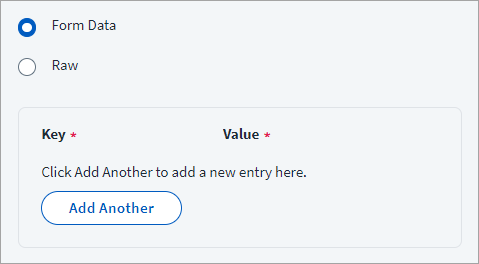Body
This is the standard HTTP body used for posting the data with a request. The Body can be configured as one of two types, Form Data or Raw data entry. Either of these is used for a specific operation.
Form Data
-
Select Form Data.
-
Add the respective data Key and Value. The Web Services source will not display an error when an endpoint's body type is selected as Form Data and the form entries are empty. The key value pairs will be sent as part of the Body in the JSON format. XML does not support form data.
Raw
-
Select Raw.
-
Enter the data in the Body field. Select Save.
<soapenv:Envelope xmlns:soapenv="http://schemas.xmlsoap.org/soap/envelope/" xmlns:bsvc="urn:com.workday/bsvc">
<soapenv:Header>
<Security xmlns="http://docs.oasis-open.org/wss/2004/01/oasis-200401-wss-wssecurity-secext-1.0.xsd">
...
</Security>
</soapenv:Header>
<soapenv:Body>
...
</soapenv:Body>
</soapenv:Envelope>Additional Information for Body
The following keywords will be used in the Body along with the placeholder $:
-
plan
-
response
-
application
-
getobject
-
authenticate
Handling the "$" Character in the URL and Body
The Web Services source correctly extracts and handles the $ character in the URL and Body, along with the placeholders.
Placeholder Details
-
The JSON request with the placeholder in the Body/Payload
If the body contains a placeholder that is not present in the provisioning plan, response, or source, the source removes the key value from the JSON payload. For example,
Copy{
"type": "$plan.type$",
"id": "$plan.nativeIdentity$",
"title": "$plan.title$",
"externalid": "12345"
}If the plan does not contain the title attribute request, the source will remove the title key and value. For example,
Copy{
"type": "student",
"id": "STUD121",
"externalid": "12345"
} -
The XML request with the placeholder in the Body/Payload
If the body contains a placeholder that is not present in provisioning plan, response or source the source removes the value from the XML payload. Refer to the following example:
Copy<worker>
<fname>$plan.fname$</fname>
<lname>$plan.lname$</lname>
<wid>$plan.nativeIdentity$</wid>
<description> permanent worker</description>
</worker>If the plan does not contain a
lnamevalue in the attribute request, the source removes thelnamevalue as displayed in the example below:Copy<worker>
<fname>John</fname>
<lname></lname>
<wid>wid121</wid>
<description> permanent worker</description>
</worker>Caution
Depending on the behavior of the API, some servers may interpret keys with a missing value as a sign that the attribute value should be blank instead of a sign that the value should be null, which may cause undesired effects. -
URL
If the URL contains a placeholder that is not present in the provisioning plan, response, or source, the source removes the value from the Request URL.
-
Header
If the header contains a value that is not present in the provisioning plan, response, or source, the source removes the key value from the Request Header.
Support for Expression Language in the Body
The web services connector supports expression language in the Body. To use expressions in the Body, wrap them with _#.
The following objects can support expression language when you use them with placeholders:
-
Response
-
Plan
-
Application
The following example is of a JSON request using expression language in the Body/Payload:
{
"type": "$plan.type$",
"id": "$plan.nativeIdentity$",
"name": "_#'hello'.concat('world')_#"
"size": _#$response.data$.length()_#,
"isActive" : _# 2 >= 2 _#
"externalid": "12345"
}Do not provide QUOTES outside the expression for values like Boolean and numbers. For example:
{
"size": _#$response.data$.length()_#,
"isActive" : _# 2 >= 2 _#
"count" : _#'Hello'.length()_#
}The following is an example of an XML request using expression language in the Body/Payload:
<worker>
<fname>_#'hello'.concat('world')_#</fname>
<lname>$plan.lname$</lname>
<size>_#$response.data$.length()_#</wid>
<description> permanent worker</description>
</worker>